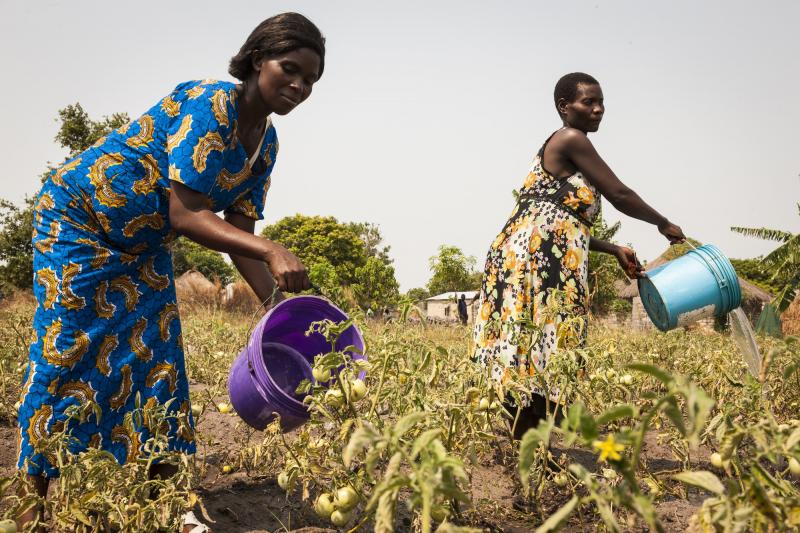I have been completing a research project that analyses the proposal documents of 19 agriculturally focused projects occurring in four African countries: Kenya, Morocco, Senegal, and Zambia. This involved the use of NVIVO coding software to mine these documents and find out to what extent transformational adaptation and social equity are integrated. Another aspect that was analysed were the vulnerabilities of marginalised groups and how they are highlighted throughout the proposal documents. In this post, I’m going to focus mainly on gender vulnerabilities that were portrayed in these documents and what inhibits gender equality in the agricultural sectors of each of these countries.

Rural women in these African countries contribute to a large proportion of the labour force within their agricultural sectors. Kenyan women make up 70% of the agricultural labour force, however, they hold only 5% of the agricultural land titles. 81% of men in Kenya individually own land while for women it is only 19%. Women in Zambia suffer similar inequalities as difficulties owning and controlling land are very prevalent. In Senegal, women farmers also constitute 70% of the agricultural workforce. They also produce 80% of food crops, but in relativity to male farmers, they produce between 20% and 30% smaller harvests. This is caused by gender disparities in the access of resources for production. By alleviating these disparities and enhancing female agricultural productivity, it is estimated that yields could increase by nearly 30 percent thus reducing the extent of the current food crisis.
Gender disparities are apparent in all facets of agricultural production. These disparities can be caused by the exclusivity of females in decision-making processes, less access to information services and services not being suitable to the needs of women, higher instance rates of HIV, and a lack of access to equipment, water, and land to achieve their agricultural tasks. In developing countries, cultural norms and previously conceived stereotypes can cause the exclusion of women from doing certain agricultural tasks that might involve heavy lifting or technical know-how. Women who are in the workforce can be subject to disparities in wages, debilitating their abilities to invest in their households, farms, or personal development. In the Moroccan agricultural sector, women can be paid up to 50 % less than men, which is the largest gender pay disparity of any sector in the country. In Senegal, there are similar disparities where women lack the same access to resources such as land, finance, equipment, and training. These disparities consequently have an adverse effect on agricultural production in the country.
Livestock is an integral part of the livelihoods of Senegalese women and children due to its nutritional and economic value. Overall, livestock contributes 30 percent of the agricultural GDP in the country. Female farmers in Zambia are mainly considered to be smallholders, with large-scale farmers (who produce most of the coffee, milk, and wheat) being predominately male. They are also heavily reliant on livestock production and subsistence crops. In some instances, any extra labour that they partake in can be paid for with food, making rural Zambezi women very vulnerable to climate change as droughts could lead to crop failures and livestock debilitation. The African Development Bank’s Oasis Climate Change Adaptation Project highlights how emigration from the project area is almost 100% males between the ages of 20 and 70 years old. This results in the areas being mainly populated by women and children hence, enhancing the reliance of females in agricultural production. This also contributes to low female education levels in the region with subsequent high rates of illiteracy (41% in rural areas). This issue is also prevalent in Zambia, consequently inhibiting the use of financial services for rural women.
Social norms and cultures could cause resistance to gender mainstreaming in rural areas. Women who live in rural areas can suffer the burden of completing household duties while also being integral to agricultural production. Women can also be inhibited by external factors, for instance, the poor quality of the rural road network in Senegal can increase the time spent fetching water or fuel. It also decreases opportunities for women to sell their cash crops in urban areas as it would involve difficult means to travel there, and they also could not leave behind their household duties. In Zambia, the prevalence of diseases, low food stocks, AIDS, and long distances to food markets all contribute to the inhibiting of female agricultural empowerment. Also in Zambia, increased commercial deforestation has negatively affected women who are forced to walk further in order to find fuel. Household duties that women are relied on to complete, take away opportunities for women to contribute to agricultural productivity and economies in general. These are some of the many factors inhibiting female empowerment in the agricultural sectors of developing countries today, but with the introduction of agricultural projects that have a greater focus on gender equality, there is hope that these components of gender inequality can be alleviated.
References:
AFB 2015. Climate Changes Adaptation Project in Oasis Zones. Proposal For Morocco.
AFDB 2014. The Agriculture Productivity and Market Enhancement Project. Project Appraisal Report Volume II.
GCF 2018. Strengthening climate resilience of agricultural livelihoods in AgroEcological Regions I and II in Zambia. Funding Proposal.
IFAD 2014. Rural Finance Expansion Programme. Programme Design Report.
IFAD 2016. Enhanced-Smallholder Agribusiness Promotion Programme Zambia. Final Programme Design Report.
VSO. 2022. Improving the economic status of women in Zambia. [online]
WORLDBANK 2013. Zambia Strengthening Climate Resilience (PPCR Phase II) Project. Project Appraisal Document.
WORLDBANK 2016. National Agricultural and Rural Inclusive Growth Project Proposal. Appraisal Document.
WORLDBANK 2019. Transforming Landscapes for Resilience and Development Project in Zambia Project Appraisal Document.
WORLDBANK 2020. Morocco Green Generation Program-For-Results. Program Appraisal Document.
WORLDBANK 2022. Enhancing Connectivity in the Northern and Central Agricultural Production Areas Senegal. Project Appraisal Document.